It must have been around noon when I skied over to Tom, a fellow New Yorker and jaded big-city type, and stated the obvious: “Wow.” He nodded his head and said in a voice that almost sounded hypnotized, “No kidding.”
After just two hours at Le Massif, we had become the skiing version of the same tourists that we goof on back in Manhattan — the ones who stand in the middle of the sidewalk with their mouths open, staring up at the skyscrapers. That’s what a 2,526-vertical foot ski area tumbling down to a nine-mile-wide Saint Lawrence River, speckled with ice floes and oil tankers, and backed by deep blue skies will do to you. It’s that impressive.
As the day wore on, the impression of skiing straight into the ocean almost turned into an annoyance because my eyes were, more often than not, locked straight ahead on the water when I should have been paying attention to what was under my feet. After getting increasingly cocky about the high success rate of my destination trips (even on those planned months in advance within the not-always-reliable northeast), I was finally receiving my comeuppance.
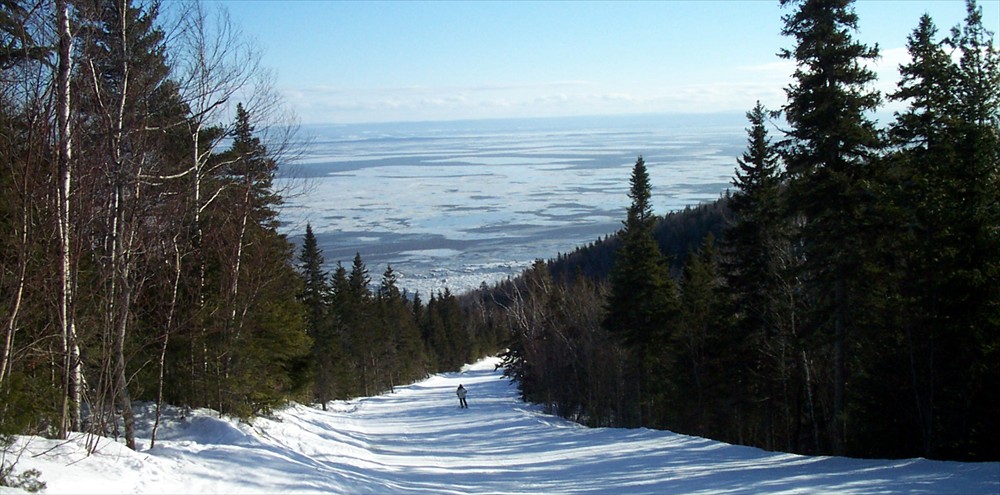
Yep, par for the course for the first two months of the 2004-05 season, a rainy thaw followed by a brutal refreeze had been forecast more than a week before my departure to Québec City. The night of my arrival, temperatures shot up into the mid 40s. The next morning, I drove north on scenic Route 138 through a near monsoon — the kind where it’s raining so hard, even with your windshield wipers at the ultra-high speed, you still can’t see anything. With liquid precipitation falling all the way to the top of the Gaspé Peninsula, radio talk show listeners were in a state of disbelief at what had happened to their sacred winter. The somber tones in their voices made it sound like the end of the world was near.
Of course, later that day, the bottom dropped out and we were back to single digits that night, freezing everything solid. When I arrived at Le Massif the following morning, the conditions board at the top of the mountain greeted me with four words that I’d see a lot on this trip: “base durcie et rapide” (hard and fast base). Even though the snowmaking crew did an incredible job getting 29 of the area’s 42 official trails and glades open, the firm conditions basically took out anything steeper than a blue square.
We hooked up with a guide, a local hardcore named Anthony, who mentioned ruefully that this would be the first time in more than a decade that he’d spend a full day on groomers. Over the next five hours, he gave us a tour of anything that was remotely skiable: fun, rolling descents with a nice constant pitch all the way down to Le Massif’s base elevation, an astoundingly low 110 feet. If you have to stick to groomed trails, with some of the best and longest cruisers in the east, this is a good place to be.
While hauling back to the top on the area’s three high-speed lifts, we could see pretty clearly that under better conditions — after a nice dump, when the woods are in play (and there are more than enough for a long weekend) — Le Massif would be a near religious experience. But that would have to wait for another visit.
We also checked out the national racing course “La Charlevoix” (featuring a hairy double-fall line section near the top), and “La 42,” the mountain’s former signature bump run, which is now served by a high-speed quad — annoying some of the locals who complain about increased skier traffic scraping down the moguls.

As ski areas go, Le Massif is relatively new. Trails were first cut in 1975 and by 1983, local skiers were being transported back to the top on school buses. In 1992, lifts were installed and the region started entertaining thoughts of transforming Le Massif into an international destination. Finally, in 2002, the ski area was bought by local moneybags Daniel Gauthier, co-founder of Cirque de Soleil. He immediately dumped more than $25 million CDN into the resort, adding a second and third high-speed quad. Gauthier also substantially improved the snowmaking capabilities, especially on the bottom third of the mountain.
Like any other ski area with ambitions to stay in the black, the ultimate goal is to build out the ski area’s terrain capacity and transform Le Massif into a four-season destination. However, Gauthier and his team have made it clear that they don’t intend to turn the mountain into the new Tremblant, in which real estate is the tail wagging the dog. Instead, they talk about creating an “environmentally sensitive operation that honors the area’s incredible natural backdrop.” We’ve heard this rap before at other resorts, and while rumors are flying around about what may be built over the next decade (including a hotel in the nearby town of Baie Saint Paul), pretty much everyone I spoke to felt that Le Massif’s plans on a variety of fronts had been carefully thought out. This, in and of itself, was news — how often do you find a majority of locals on the same page about an extensive expansion?
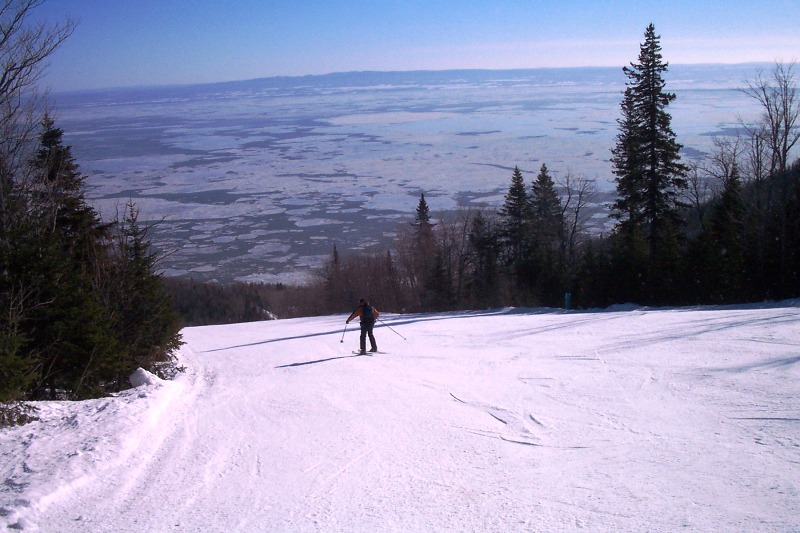
At 4 pm, we headed to the new summit lodge, a rustic, wood-filled building with a full après-ski scene, including a beer-tasting event, local artists painting in the atelier above the pub, and a French-Canadian rock group onstage. And even though I normally couldn’t care less about the ski-lodge cafeteria, Le Massif deserves praise for serving food that looks and tastes like something you’d get at a decent restaurant (of note: they don’t fry anything there). While Tom and I were nursing beers and discussing where to go for dinner that evening, Anthony informed us girly men from south of the border that he was going whitewater paddling, despite the fact that it was zero degrees Fahrenheit outside.
With a medium-sized ski area directly next to a huge body of water, surrounded by quiet forests, and 300 inches of annual snowfall (second only to East Coast powder king Jay Peak), Le Massif is one of the most unique ski areas you’ll find anywhere: east or west. Even with barely 60% of its terrain open, you can’t help but be impressed by this place. And if my point-and-click photos don’t convince you, take a spin through the mountain’s website. They don’t cheap out on their marketing collateral.
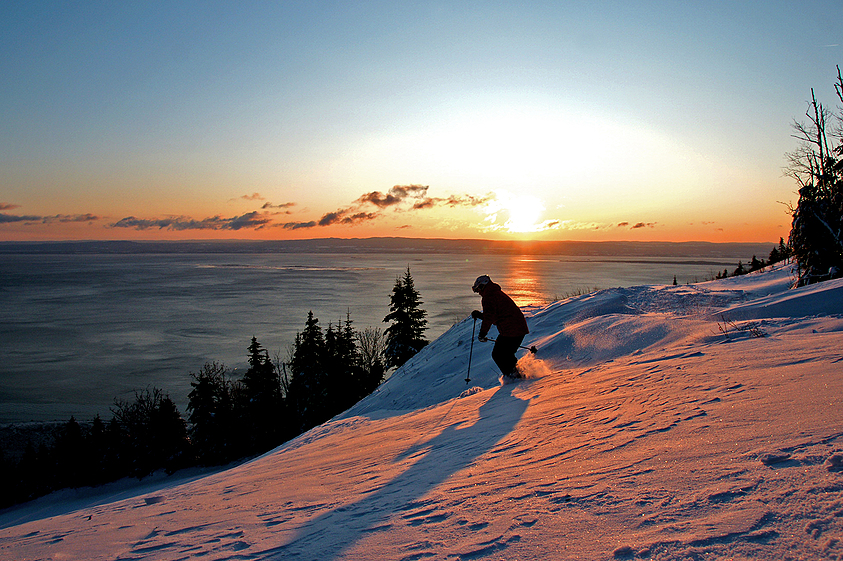
Editor’s Note: Although most people continue to refer to the mountain as “Le Massif,” since the publication of this article five years ago, it was officially rebranded as “Le Massif de Charlevoix” (pronounced shar-luh-vwah) to help avoid confusion with “Le Massif du Sud,” a ski area located on the eastern side of the Saint Lawrence River. For historical accuracy, we used the 2005-era logo and name in this article.
Sleeping It Off
Similar to Utah’s Snowbasin, Le Massif finds itself in an interim phase of development — too well known to be considered a locals’ mountain, but without on-mountain hotels or condos, not yet a destination resort. When I called to enquire about a hotel, they directed me to one of the area’s many privately-owned bed & breakfasts and inns: the Cap-aux-Corbeaux auberge about 15 minutes away on Route 362.
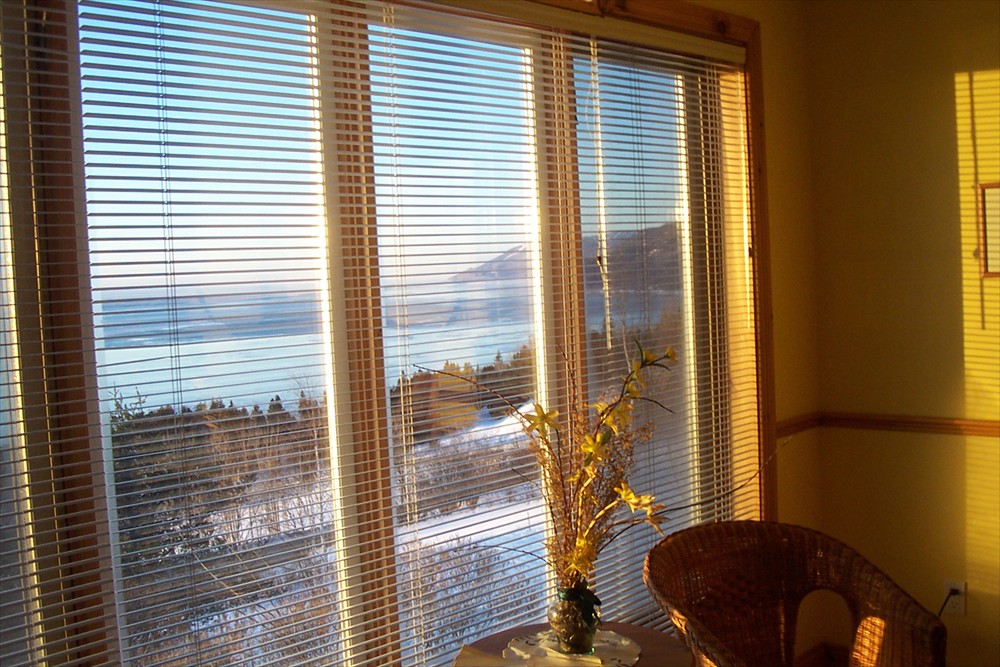
When owner Pierre Prud’homme opened the door to my second-floor room, my mouth dropped from the gorgeous, panoramic vista of the river through my window. From left to right, I had a front-row seat of that amazing view all the way to the ski area in the distance.
Each morning, I went downstairs for a big breakfast in a gorgeous dining area with that wrap-around sightline. Saturday evening, we got the full treatment: a fantastic four-course dinner with a selection of fine wines, served by a waiter in formal attire.

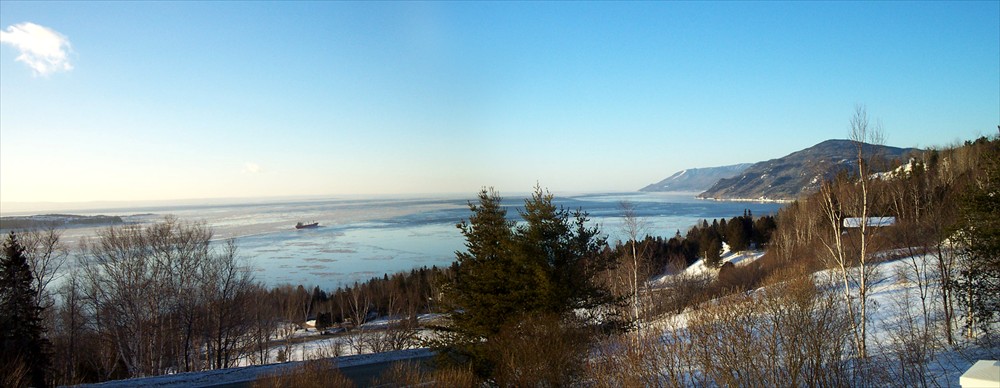
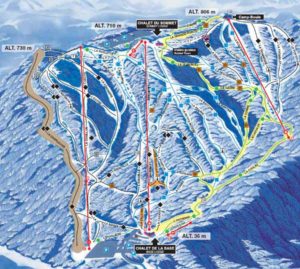
Thanks James, this article brings back great memories. I skied Le Massif in the late 80s, back in the school bus days. The story I heard was that the Quebec government had put in a pile of money to develop the resort, then pulled the plug after the runs were cut. A local initiative got the busses running.
We were there in the spring and had great conditions. Good thing, because there was no grooming! The school bus ride was was something else. Skiers parked at a small lodge at the top, then were organized into bus groups loosely based on ability. Each bus group had two guides to make sure everyone went down the right trails (there were no maps or signs that I recall) and made it back on to the right school bus. The ride up the steep winding road to to top took about 20 minutes, not much longer than a lift ride (at the time) probably would have taken.
Every run was top-to-bottom. The day pass guaranteed you four runs and you could pay a little extra for one more. We did, and after five runs, telemarking in spring conditions, we were pooched. I’m looking forward to going back and riding a lift!
James … Really nicely done. While I do help with the backend stuff, and technically I “see” your work in advance, it’s still a treat to read it for real, when it’s completed.
Interesting that Le Massif was continue the Gore tradition of “ride up – slide down.”
I think your point-and-shoot does/did rather nicely. One thing about your appreciation for culture, cuisine, and all things French … seems like you still managed to have a good time, even though conditions were pretty tough.
Question … the name Le Massif … does it translate simply to a variation of the word “large,” does it have geological meaning or is it something else?
Harv, I can’t comment on the ski resort’s choice of names but a “massif” is not only a French word but both a geological and mountaineering term. From the most valued of sources, Wikipedia (bold text by me for emphasis):
“In geology, a massif is a section of a planet’s crust that is demarcated by faults or flexures. In the movement of the crust, a massif tends to retain its internal structure while being displaced as a whole. The term is also used to refer to a group of mountains formed by such a structure.
In mountaineering and climbing literature, a massif is frequently used to denote the main mass of an individual mountain. The massif is a smaller structural unit of the crust than a tectonic plate and is considered the fourth largest driving force in geomorphology.
The word is taken from French (in which the word also means “massive”), where it is used to refer to a large mountain mass or compact group of connected mountains forming an independent portion of a range.”
That’s why their logo is brilliant. There is the “M” of massif but also the representations of the river and a “compact group of connected mountains forming an independent portion of a range.”
Great question. Wikipedia defines a massif as “a group of mountains formed by a section of a planet’s crust that is demarcated by faults or flexures.” IMHO, the key word in that description is “group.” Many feel that Le Massif (the ski area) is a bit of a misnomer because it isn’t truly part of a group of mountains like the aforementioned Massif du Sud ski area, which is officially part of the Appallachian Mountains.
In French, it might be more precise to call Le Massif (the ski area) a “cap” — an elevated land mass that sticks out into the ocean. Unfortunately, it doesn’t have quite the same sexy ring as “Massif.”
Maybe a geographer could provide a more precise explanation?
Awesome! I have anxiously awaited this piece since I first saw it listed as soon to be published. Great opening. I do not think I will get up there this year since it will command a multi-day trip and I am pretty well booked up for this season. But I plan to make time to get up there during 11-12.
I never actually rode the bus, blame it on mononucleosis. My first trip skiing around Quebec City was in March 85 and I was still feeling the effect of mono. I had promise my gf at the time to take it easy. I was with Gillesski, one skier partner which I’ll mentioned when I get to recreate my old TRs from my CEGEP years. The plan was to ski 2 days at MSA and 1 at Le Massif. Decided against it as I didn’t have the energy and didn’t feel up for it. We drove by the road down to the village, snow banks higher than the roof of the car.
Le Massif by bus would be 4 runs for something like $20… or you could take 5 runs for $25. Martinski, another great skier partner part of our triumvirate of era which I mentioned on FTO a few times moved out to BC in 87. Martin skied Le Massif with bus. I remember his tales plus I have my own maps from that era, as I was hoping I would go, never happened.
As for beta, most trails were clusted around where the original runs are plus La 42 would be far away and you could ski up across the train tracks and on to the St. Lawrence river. Well, that what Martin told me at the time.
On the Quebec government initiative, I remember seeing that study on self at the U of M sport library while I was researcher a term paper for my last year geography course on how much the Von Thunen model applied to the Quebec Ski Industry. I remember browsing it, Le Massif was suppose to have something like 58 runs, run 42 on the initial plan. The others also had numbers, the map is in a box somewhere and I’ll eventually get it out once Ski Mad World blog is more up to date.
No need for a geographer, Sick Bird is dead on on the definition and why (I presume) it’s called Le Massif.
The geological history of the Charlevoix region is well defined in the geology section.
About the name or evolution of the name.
The original name was Massif de la Petite-Rivière-Saint-François which eventually became Le Massif. Petite-Rivière-St-François (Small St. François River) is the name of the village on the shore of the St. Lawrence near the base of the ski area. Le Massif was having issues with the ski area named Massif du Sud in the Appalachian south of Quebec City. Le Massif is part of the Canadian Shield. I believe they went to court and lost. The new name is set to be less local and identifies itself more to the region as a whole, le Charlevoix.
Great article. I knew little about this mtn.
We are fortunate to have Jamesdeluxe. He brings always professional quality writing. His articles are on par, even better, than the ones in national publications. His style is excellent and concise. Precision wording without being dry, he takes us along for the trip. Well done James!
Jamesdeluxe is one of my favorite online ski writers. Always a good read.
James, As a first-time reader of the Magazine, I discovered with pleasure the excellence of your wordcraft, marvelous photography and compelling narrative. And I am NOT a skier. On the topic of Massifs, however, I have a hiker’s familiarity with them. I have spent a significant amount of time, over the years, in the Italian Dolomites where there are several e.g. Brenta Massif et al.
Keep up the fine work. I look forward to returning to the Magazine.
Hi I really love this article.
I am 26 years old from Montreal and have been dreaming for the day I will ski Le Massif de Charlevoix.
I was there this weekend and it was incredible!!! I can compare it to Whiteface in Lake Placid.
Thank you for the article I am interested in knowing more of the history of this fantastic ski hill and look forward to its development as a full ski resort.
It is a hidden gem for sure.